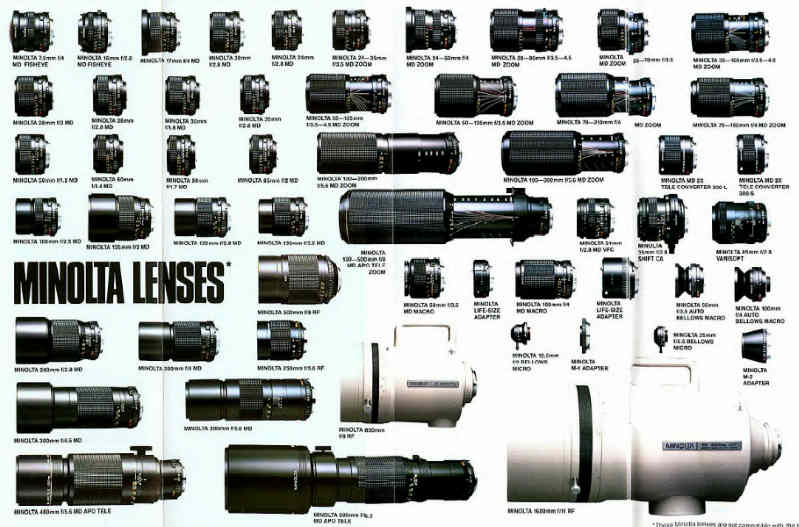

Mr. Kazuo Tashima, the founder of Minolta, decided on a name for his camera lenses while gazing out his office window one day. Looking over the ripening rice fields (Minolta, pronouced Min-o-ROO-ta, means "ripening rice fields"), he saw Mount Rokko was in the distance, and so the Rokkor name was born. Minolta made SLR lenses in several series with several features evolving over the years. The various series of lenses can be confusing in features, but also in their timelines. Most lenses evolved over time, so that the same lens at the beginning of a lens series did not look like the same lens at the end of the lens series. In addition, most lenses were not made during the entire time period of the series in which they were made. A good example, is the 40-80mm ROKKOR-X zoom lens. It made its appearance toward the end of the MC Rokkor-X line. Then it showed up at the beginning of the MD Rokkor-X series, but only for a short period of time. So you can find this lens in two different series with different features. And watch out for even more subtle changes. Some lenses that don't seem to have changed over the years really have. For instance, the 50mm f1.4 had 7 elements in 5 groups in the MC series, but has 7 elements in 6 groups in the MD series. And the 16mm f2.8 fish-eye which was present from about 1968 with 11 elements in 8 groups became 10 elements in 7 groups around 1980. Unless people remain calm, cool, and collected, arguments can ensue needlessly about the lens specifications. To make matters even more complicated, many of the same lenses were marketed in different parts of the globe with different designations! So people can conclude that there were more Minolta lenses than there really were. (ON THIS WEBSITE WE ONLY USE THE U.S. MARKETING DESIGNATION) We really feel sorry for you poor bastards in non-US markets, but don't blame us.
Thanks to the longevity of the Minolta lens mount, every manual-focus Minolta-style lens will fit on any Minolta-style manual-focus camera. Even the oldest Minolta lens (1958 Auto Rokkor) will fit and function on the newest Minolta camera (2003 X-370). Reciprocally, the newest manual-focus Minolta lenses (2003 MD Minolta) will fit on the oldest manual-focus Minolta camera (1958 SR-2). No other SLR camera company can make this claim! But just because you can get a particular Minolta lens to physically attach to a particular Minolta camera does not mean that all of the features of the lens or camera will be useable. For example, if you put a new lens on an old camera, the new features of the lens may not be useable. Conversely, if you put an old lens on a new camera, the new features of the camera might not be useable. The details on using cameras and lenses are listed under each lens category.
Minolta lenses are the longest running series of SLR lens-camera compatabilities in the world -- 1958 to the present. All the other camera companies either stopped making SLR cameras altogether or they were forced to make substantial changes to their lens mount along the way in order to stay competitive. This, of course, prevents their newer lenses from working on their older cameras, and vice versa. For example, Pentax, Yashica, Mamiya, Olympus, Fuji and several other camera manufacturers started their SLR camera lines with screw-mount lenses. They eventually had to make the switch to the much more convenient, bayonet mount in order to allow advanced features on their lenses -- such as automatic diaphragms and TTL meter-couplings. Since a screw-mount lens rotates several times while it is being attached to the camera body, it cannot incorporate fixed linkages designed to mate with pins in the camera. And without the best convenience features, the screw mount cameras could not compete for customers against the feature-rich Minolta cameras. So these companies eventually switched away from the screwmount. Several of these companies went out of business in the process. Every hear of Petri or Miranda cameras?
For those that made the switch, their older screw-mount lenses will not work on their newer camera bodies without an adapter -- and then they only function in a limited capacity. And don't even think about putting one of their new lenses on one of their older cameras -- adapters are not available. So if you had an old camera, and they developed a new lens, you were just out of luck.
"Professional" gear was not immune to this evolution. Although Nikon used a bayonet SLR system from the beginning, they finally were forced to switch from their original, awkward, meter-coupling system of the F camera to the Minolta-like AI system. This left their older lenses in the dust-bin. They will only work with an expensive fix. And how about Canon? Well, they started out with a frustrating, breech-lock system that requires three hands just to change a lens. They, too, eventually gave it up and went to the more sensible bayonet system that allows a lens change in the dark -- with one hand -- something that Minolta users has been enjoying for years!
In short, Minolta got it right from the beginning. They avoided all of these problems when they created their original lens mount and lens design. The original Minolta lenses were typically designed to have the aperture ring right next to the camera body. Most other camera companies placed this ring out toward the front of the lens. When it came time for lenses and cameras to talk to each other -- for metering and auto-exposure purposes -- Minolta was well ahead of the game. They only had to make relatively minor adjustments to their lenses while everyone else had to "go back to the drawing board" and come up with completely new lens series, infuriating many of their loyal customers.
Since automatic lenses remain at the maximum aperture, the meter has no way of knowing what the actual f-stop setting is. Most companies got around this by using "stop-down" metering. In this approach, you have to press a lever to stop-down the lens, and at that point the meter can take a reading.. Not only is this awkward sinc eit requires an additional "step", it defeats the whole purpose of an automatic lens system -- to keep the lens open and the viewfinder bright until the moment of exposure. Minolta was able to avoid this whole problem of "stop-down" metering because they had designed most of their lenses, from the beginning, to have the aperture ring next to the camera body. All Minolta had to do was make a minor modification to the f-stop ring on their lenses to tell the meter what the f-stop was set at. It's the same thing with f-stops in the viewfinder. This was easy for Minolta to accomplish because the f-stop ring was located next to the pentaprism from the very beginning. Other camera firms came up with excuses and expensive fixes. And while the older Minolta lenses do not have all of the automatic features of the newer lenses and cameras, they are still very useable on the newest cameras.
But Minolta lenses were far from static over time. New lenses were constantly added to the available arsenal, and various changes were made to the optical formulas and the lens features and cosmetics. To help make sense of it all, Minolta lenses are often grouped by time period or lenses series (see below), based on the primary features of the lenses. One way to help seperate the lenses is to look at the inscription on the front. Here are the faceplates of the various Minolta 135mm f2.8 SLR lenses in chronological order. Keep in mind that all of these lenses have different features.
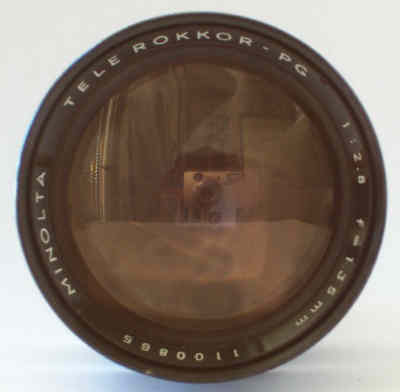
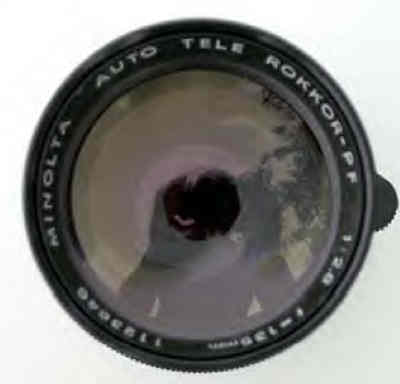
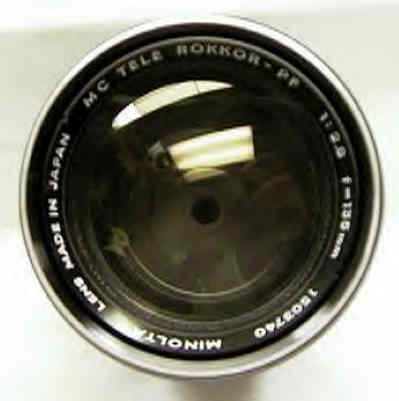
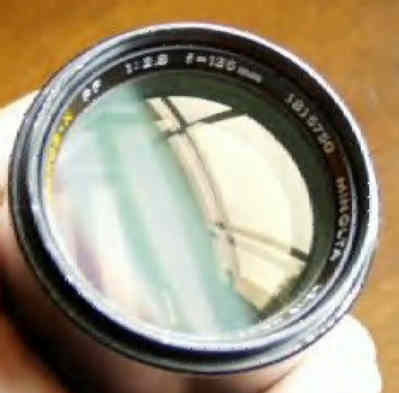
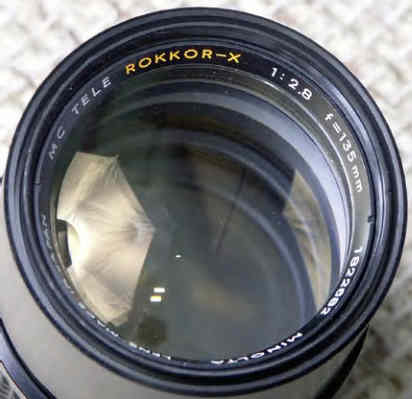
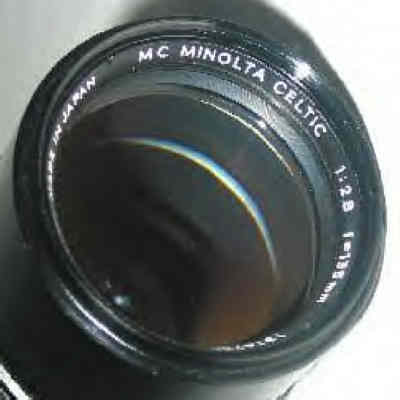
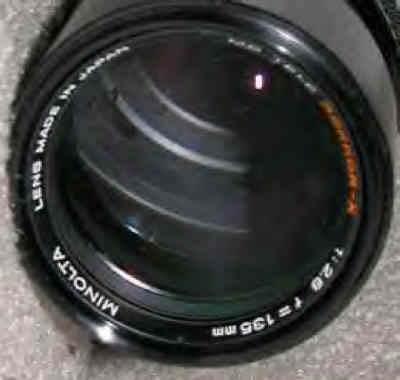
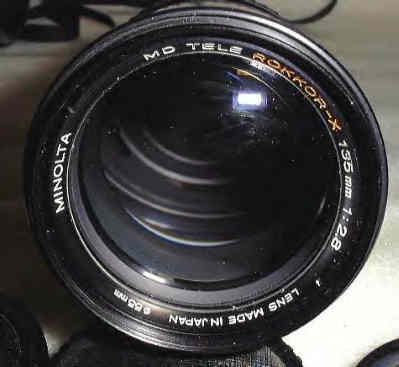

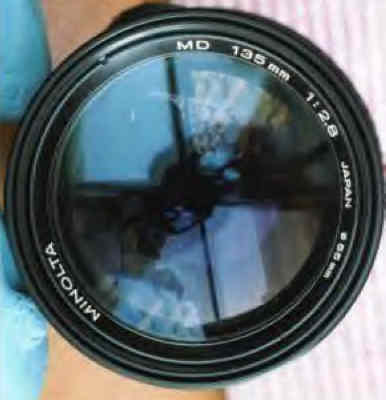
Many Minolta lenses have an odd letter designation printed on the front, such as Rokkor 35mm HH. This letter designation refers to the optical make-up of the lens. The first letter refers to the number of groups in the lens: T=3; Q=4; P=5; H=6; S=7; O=8; N=9. The second letter refers to the number of elements in the lens: C=3; D=4; E=5; F=6; G=7; H=8; I=9; J=10; K=11; L=12. So an "OK" lens doesn't mean it just passed inspection. It means that the lens has 8 groups with 11 elements, for example.
Minolta also made various lens converters and adapters that are useable with most of these lenses.
There were, of course, many other companies besides Minolta that made lenses to fit on Minolta cameras. Just a few of the names are: Soligor, Tamron, Sigma, Vivitar, Sun, Asanuma, Owen, Bushnell, Osawa, and Tokina. Some of these lenses are of high optical quality, but many are not. When selecting a non-Minolta lens, it's essential to select a lens that provides the level of picture quality that you want, since it is the lens -- not the camera -- that determines the quality of the image. First, compare the non-Minolta lens to an equivalent Minolta lens and see if it has fewer lens elements. This is a common way that competitors cut corners. Is the lens multi-coated? Is the inner-barrel sufficiently baffled to prevent internal reflections? Were any test reports done on the lens in the photographic magazines? These, and other factors, can impact the picture quality. But above and beyond the issue of picture quality, there is the issue of the quality of the non-glass materials in the lens. Many lenses have plastic parts. While reducing weight, they may not hold up under rough conditions or long-term use. And there are many other considerations. Which way does the focusing ring turn? Does it rotate in the same direction as all of your other Minolta lenses (which all rotate the same way)? If not, it can be difficult to get used to. How about the aperture ring? Does it rotate in the same direction as your Minolta's lenses? Believe it or not, some don't. Does it have 1/2 stop detents? Is the f-stop ring imprinted such that the f-stops will appear in the viewfinder? Is the lens auto-aperture? Is it meter-coupled? Does it have the MD feature for the XD and X-700 cameras? What is the filter thread size? Is it standardized like the Minolta lenses or will you have to buy an adapter? Is the lens designed for multiple camera systems, so that you'll need an adapter to attach it to your Minolta camera? If so, these cameras typically have markings designed for other camera systems -- such as f-stop indications in two directions -- that can be confusing. There are many other features to compare as well, such as the lens weight, size, close-focusing distance, built-in depth-of-field scale, infrared marking, etc. When you compare all of the features, you will likely realize that the genuine Minolta lens is a much better deal -- especially at today's prices. For as complete a list as possible, of non-Minolta lenses that will fit on Minolta cameras, here is a Third Party Lens Manufacturer list.
| PRIMARY LENS FEATURE | 1958-1966 | 1966-1972 | 1972-1977 | 1977-1981 | 1981-present |
|
manual diaphragm |
Rokkor | MC Rokkor-X Leitz |
MD Rokkor-X | Non-Rokkor | |
|
auto-diaphragm added |
Auto-Rokkor | MC Rokkor-X | MD Rokkor-X | Non-Rokkor | |
| MC Rokkor | |||||
| MC Rokkor-X, MC Celtic |
|||||
| MD Rokkor-X MD Celtic |
|||||
| Non-Rokkor |
If you are able to provide additional information, please contact us at xkaes@aol.com.
RETURN TO THE MANUAL MINOLTA HOME PAGE
We didin't want to do this, but since other websites have been stealing our stuff, we have no alternative but
to state:
COPYRIGHT@1995-2023 by Joe McGloin.
All Rights Reserved. The material on this website is protected by US Federal copyright laws. It cannot be copied
or used in any manner without specific approval from the owner.
The material on this website is protected by US Federal copyright laws. It cannot be copied or used in any manner without specific approval from the owner.